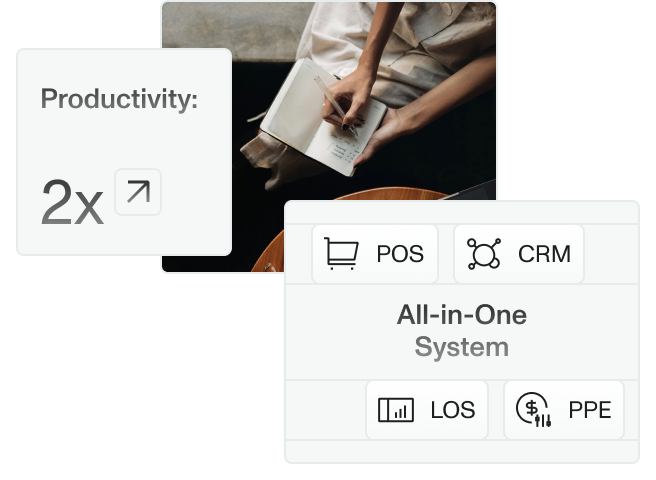Mortgage rates for conventional loans are determined by two considerations: the federal mortgage rate and loan level price adjustments (LLPAs). LLPAs are important for originators because they help them understand the credit risk inherent in a specific loan.
What are Loan Level Pricing Adjustments?
LLPAs are price adjustments lenders use to account for risk associated with particular loan characteristics. These adjustments are based on varying factors such as credit history, down payment amount, and property type. Each of these factors can be assigned a “price adjustment.”
LLPAs were introduced in 2008 by the Federal Housing Finance Agency (FHFA) to protect Fannie Mae and Freddie Mac from market losses. The FHFA created a matrix that contained different LLPAs for each borrower or loan type. This matrix was designed to fix the financial mayhem caused by high-default, government-backed mortgages.
Most borrowers are subject to LLPAs. An example of a mortgage that would not trigger an LLPA is a borrower purchasing a single-family, detached home with a 740 or higher credit score and at least 40% down.
Factors that Impact LLPAs
Various factors can impact LLPAs, including credit score, loan-to-value (LTV) ratio, loan purpose and amount, property type, and debt-to-income ratio. Credit scores and debt-to-income ratios are the only factors the borrower can influence during the mortgage process. Other details, such as LTV ratio and loan purpose, are impossible to change, as they are associated with the property.
Fannie Mae and Freddie Mac publish their LLPA matrices so originators can always determine an accurate price.
Why Lenders Use LLPAs
LLPAs are not optional fees; Freddie Mae and Freddie Mac levy them. Lenders who want to issue conventional mortgage loans must include necessary adjustments.
In addition to being required, LLPAs are also beneficial for lenders. They can increase their profit margins on certain loans by charging slightly higher interest rates or fees to borrowers with weaker credit scores.
Calculating LLPA
The process of calculating LLPAs is straightforward. Most lenders use a pricing engine to help automate the process. Alternatively, a manual calculation can also be completed.
When using a pricing engine, originators enter borrower and loan information into the system, and the engine calculates an appropriate LLPA for each scenario.
When doing manual calculations, originators look at the published LLPA matrix from Fannie Mae or Freddie Mac to determine the adjustments for each factor.
To illustrate an example of LLPAs, imagine a borrower with a credit score of 720 and an LTV ratio of 80%. In this case, the LLPA would be 1.25%.
Now think of a borrower with a credit score of 680 and an LTV ratio of 80%. The LLPA jumps to 1.75%. The stark difference in the two adjustments results from the lower credit score.
How do Loan Level Pricing Adjustments Impact Borrowers?
LLPAs can profoundly impact borrowers’ mortgage costs; even small changes can make a significant difference in the long run.
For instance, if a borrower were to apply for a mortgage with an interest rate of 6%, a 1% LLPA absorbed into the mortgage would raise the rate by nearly a quarter percentage point. A $200,000 loan amount could add more than $7,000 to the total loan cost over a 30-year period.
Given how substantial LLPAs can be, originators must communicate their impact in a clear and transparent way. Borrowers need full disclosure of the cost associated with LLPAs throughout the entirety of a loan application.
Originators can work to reduce borrowers’ LLPAs by coaching them on how to improve their credit scores and pay off some debt. A 20-point credit score increase moves borrowers into a less-risky loan category, reducing their LLPAs. Some borrowers may get the 20-point jump just by disputing charges or other simple steps.
Managing LLPAs Effectively
To manage LLPAs effectively, lenders must understand the factors that drive them. LLPAs take into account data points about the borrower and property. Does the borrower have poor credit? Is the property a second home?
It’s possible to minimize LLPAs with the right strategies. If you’re working with current high-risk borrowers, try to help them improve their credit scores. Structuring loans with lower LTV ratios can also help reduce LLPAs.
However, LLPAs cannot be eliminated entirely. Therefore, it’s critical to have tools in place to manage them. Pricing engines are a great way to determine the most efficient way to structure a loan. They allow you to see all the options to make the best decision for the borrower.
Automation helps streamline the process further. Automation ensures that all the necessary steps are followed, minimizing any potential errors and ensuring accuracy.
Everything Else You Need to Know About LLPAs
Negotiating LLPAs is a skill that originators must learn. Know which factors impact pricing most and how to adjust those factors to get the best deal possible for the borrower.
Some low-income borrowers may be charged discount points upfront, in addition to LLPAs. Interest rates on conventional mortgages legally cannot go above a predetermined maximum, so if a borrower reaches this maximum through LLPAs, lenders may apply discount points to lower the rates. Discount points are paid during closing.
Borrowers who want to avoid LLPAs altogether can apply for FHA, VA, or USDA loans instead.
Boost Your Revenue with Sonar
A thorough knowledge of LLPAs will help you provide borrowers with their best options, solidifying your reputation. Instead of sticking with manual calculations, use an advanced loan origination system (LOS) like Sonar to quickly and easily calculate LLPAs for your borrowers.
Sonar’s comprehensive platform helps lenders and originators manage their mortgage pipelines from start to finish. By using Sonar, you can offer more competitive rates to your borrowers and improve your revenue potential. With easy access to data from all stages of the loan process, lenders can manage LLPAs and make informed decisions quickly.
Secure a brighter future for both your borrowers and your bottom line. Schedule a demo today to discover how Sonar is revolutionizing the origination process.








